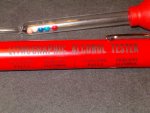Tarun Chopra
Well-known member
Hi,
Whenever fresh font is prepared the amount of alcohol can be verified with things like "alcoholometers" hydrometers without any additives like font solutions etc and the readings are very accurate, we can accurately estimate the amount of alcohol in water and then add font solution to specifications.
The problem which I am facing is the next day... when the font level in the chiller tank falls and when fresh additive is added how to verify the alcohol content in contaminated font solution? The hydrometer actually pops out completely?
I am being told by press operators that they have to add alcohol without measurement to avoid scumming during week days!!!
How do auto-dosage systems work? Do they keep on increasing alcohol dosage to avoid scumming during week days top-ups, is there a rule to this practice?
Thanks
Tarun Chopra
Whenever fresh font is prepared the amount of alcohol can be verified with things like "alcoholometers" hydrometers without any additives like font solutions etc and the readings are very accurate, we can accurately estimate the amount of alcohol in water and then add font solution to specifications.
The problem which I am facing is the next day... when the font level in the chiller tank falls and when fresh additive is added how to verify the alcohol content in contaminated font solution? The hydrometer actually pops out completely?
I am being told by press operators that they have to add alcohol without measurement to avoid scumming during week days!!!
How do auto-dosage systems work? Do they keep on increasing alcohol dosage to avoid scumming during week days top-ups, is there a rule to this practice?
Thanks
Tarun Chopra














